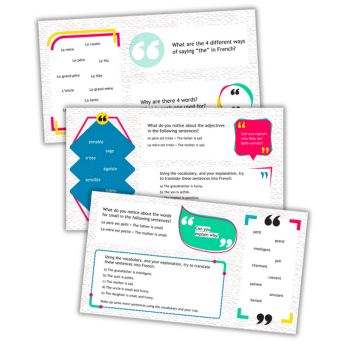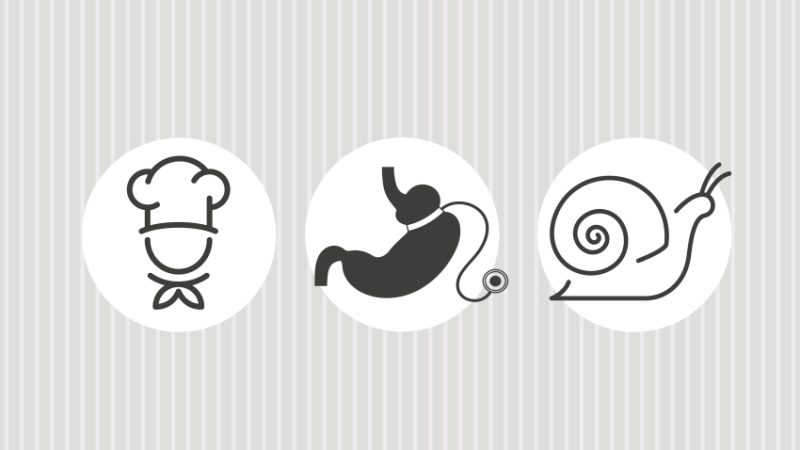How to Introduce Gendered Nouns in KS3 French

French language learners can often struggle with the concept of gendered nouns, says Dominic McGladdery – but how you introduce it to them can make all the difference…

In our defence, one of the hardest things about learning other languages is the grammar. And I think that one of the trickiest aspects of French grammar is getting to grips with the concept of masculine and feminine nouns.
Alas for struggling learners, knowing the gender of nouns is incredibly important, because it has a knock on effect on understanding many other grammatical concepts, such as conjugating verbs – and the topic I want to write about here: adjective agreement.
Before I continue, though, there is something you really need to know. I wouldn’t tell just anyone this, but here goes: French tables aren’t feminine. There, I said it. They just aren’t.
Neither, come to that, are bananas, pencil cases, coffee cups, or cars. And while we are at it, coffee isn’t masculine, either. Nor are books, pens, pencils, sandwiches, or cheese. They just aren’t. Sorry.
These words do fall into the two distinct groups of nouns that we tend to label ‘masculine’ and ‘feminine’, yes; but we could just as easily call them ‘orange’ and ‘yellow’, ‘E’ and ‘F’, or ‘chalk’ and ‘cheese’ nouns.
A better way
Students have often asked me why nouns have different genders in French. I expect they’ve asked you, too; so here are three possible answers:
First, you could explain to them that masculine and feminine nouns were originally used to describe masculine and feminine things. Language then evolved, so that similar sounding words were given masculine and feminine genders.
Secondly, French is derived from Latin, and Latin has different classes of nouns which we call ‘genders’.
Or, thirdly, my favourite, and the lazy teacher’s go-to excuse for everything: they just do.
There are ways of recognising the gender of a French noun by its ending – for example, nouns ending in -eur tend to be masculine, but extreme caution is needed for beginners, as this is not always the case.
In the past I have witnessed teachers tell Year 7 French students that nouns ending in ‘e’ are feminine. I know why; it’s because they’ve taught them all about masculine and feminine nouns while covering the topic of ‘classroom objects’.
And it just so happens that, coincidentally, most of the relevant vocabulary which ends in ‘e’ is feminine: la table, la chaise, la porte, la trousse, la règle, etc…
However, given that a quick internet search tells us that around 30% of French nouns ending in ‘e’ are masculine, I can’t help but think there must be a better way of teaching agreement and gender.
Learning the rules
My suggestion is to start with describing family members. For beginners, this is the ideal way to introduce gendered nouns; after all, male family members are patently masculine and female family members are likewise feminine.
Begin, then, by teaching your Y7 students the vocabulary for mother, father, brother, sister and so on. It doesn’t matter how you do it, although in the target language with pictures would be ideal.
They will soon come to the conclusion, especially if you press them, that there are different ways of saying expressing the definite and indefinite articles in French, and that they appear to be linked to gender (you can unpick this, as above, later).
After some practice, I would give the students some examples of basic descriptions in French.
For example: “Le père est petit” and “La mère est petite”. At this stage, I would not go into the even more confusing world of putting adjectives after the nouns they describe – or not, as the case may be – but would simply stick to working on agreement.
Students would then be asked to comment on what they notice about the two sentences. Very often, a learner will venture that one of the sentences must be wrong.
A logical deduction, but this is the point to explain that they are both correct, and to ask the class to see if they can explain why. At this stage, I might give them more pairs of sentences to help them come up with a rule.
Deeper understanding
When the students have come up with their rule, they should receive another pair of sentences to throw a spanner in the works: “Le père est mince” and “La mère est mince”. Again, armed with their new understanding, they will possibly try to claim that one of the sentences is wrong.
So now they have to adapt their rule, to incorporate adjectives which end in ‘e’. Once they have done so correctly, they can complete the next part of the task: a Venn diagram.
The left circle is for masculine adjectives, the right one is for feminine adjectives, and the middle section is for the adjectives which could be used with both masculine and feminine nouns.
This is an effective way for students to show that they have understood the rule about adding an extra ‘e’ to feminine adjectives, unless they already end with an ‘e’.
Once this has been mastered, it’s time to introduce the students to adjective agreement with plural nouns. Again, this can be done by giving examples and by asking students what they notice. For example: “Les cousins sont petits” and “Les cousines sont petites”.
Take notes and feedback on all of their answers and then, as a group, come up with a rule which will help them to understand the concept. Get the students to test their theories with some other words they know, until they are sure they have the correct one.












